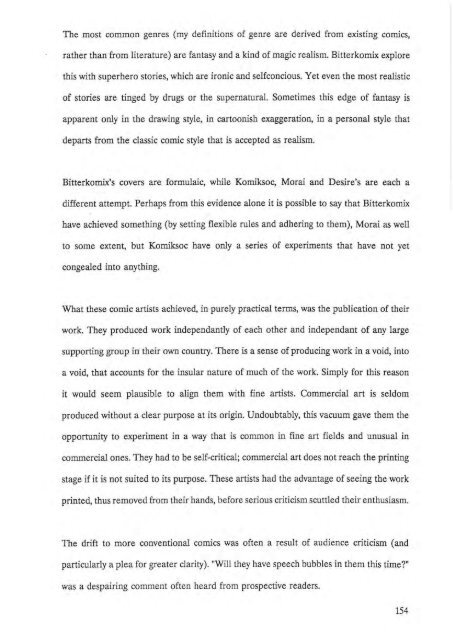Text - Rhodes University
Text - Rhodes University
Text - Rhodes University
Create successful ePaper yourself
Turn your PDF publications into a flip-book with our unique Google optimized e-Paper software.
The most common genres (my definitions of genre are derived from existing comics,<br />
rather than from literature) are fantasy and a kind of magic realism. Bitterkomix explore<br />
this with superhero stories, which are ironic and selfconcious. Yet even the most realistic<br />
of stories are tinged by drugs or the supernatural. Sometimes this edge of fantasy is<br />
apparent only in the drawing style, in cartoonish exaggeration, in a personal style that<br />
departs from the classic comic style that is accepted as realism.<br />
Bitterkomix's covers are formulaic, while Komiksoc, Morai and Desire's are each a<br />
different attempt. Perhaps from this evidence alone it is possible to say that Bitterkomix<br />
have achieved something (by setting flexible rules and adhering to them), Morai as well<br />
to some extent, but Komiksoc have only a series of experiments that have not yet<br />
congealed into anything.<br />
What these comic artists achieved, in purely practical terms, was the publication of their<br />
work. They produced work independantly of each other and independant of any large<br />
supporting group in their own country. There is a sense of producing work in a void, into<br />
a void, that accounts for the insular nature of much of the work. Simply for this reason<br />
it would seem plausible to align them with fine artists. Commercial art is seldom<br />
produced without a clear purpose at its origin. Undoubtably, this vacuum gave them the<br />
opportunity to experiment in a way that is common in fine art fields and unusual in<br />
commercial ones. They had to be self-critical; commercial art does not reach the printing<br />
stage if it is not suited to its purpose. These artists had the advantage of seeing the work<br />
printed, thus removed from their hands, before serious criticism scuttled their enthusiasm.<br />
The drift to more conventional comics was often a result of audience criticism (and<br />
particularly a plea for greater clarity). "Will they have speech bubbles in them this time?"<br />
was a despairing comment often heard from prospective readers.<br />
154
















